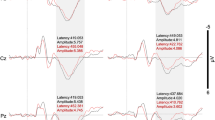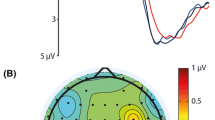Abstract
We investigated differences in the cognitive/attention process following visual stimulation of the left and right hemi-visual fields. Visual P300 was recorded in 31 healthy right-handed subjects following target and non-target stimuli presented randomly in both visual fields. Counting and reaction time (RT) tasks using the left and right hands were performed. The P300 amplitude was significantly smaller in the RT session using the left hand. The amplitude was larger following target stimulation in the left hemi-visual field in the RT sessions using both the left and right hands. The P300 latency did not change in each stimulus condition and session, but the RT was longer for the target in the right hemi-visual field in the RT session using the left hand. We showed asymmetry of P300 response following each hemi-visual field in healthy subjects, and visual stimuli in the left hemi-visual field were dominantly processed.





Similar content being viewed by others
References
Schenkenberg T, Bradford DC, Ajax ET (1980) Line bisection and unilateral visual neglect in patients with neurologic impairment. Neurology 30:509–517
Ferro JM, Kertesz A, Black SE (1987) Subcortical neglect: quantitation, anatomy, and recovery. Neurology 37:1487–1492
Kleinman JT, Newhart M, Davis C, Heidler-Gary J, Gottesman RF, Hillis AE (2007) Right hemispatial neglect: frequency and characterization following acute left hemisphere stroke. Brain Cogn 64:50–59
Ciçek M, Gitelman D, Hurley RS, Nobre A, Mesulam M (2007) Anatomical physiology of spatial extinction. Cereb Cortex 17:2892–2898
Malhotra P, Jäger HR, Parton A, Greenwood R, Playford ED, Brown MM, Driver J, Husain M (2005) Spatial working memory capacity in unilateral neglect. Brain 128(Pt 2):424–435
Karnath HO, Dieterich M (2006) Spatial neglect—a vestibular disorder? Brain 129(Pt 2):293–305
Bartolomeo P, Thiebaut de Schotten M, Doricchi F (2007) Left unilateral neglect as a disconnection syndrome. Cereb Cortex 17:2479–2490
Bruyer R (1986) Lateral differences in visual processing: relative vs exclusive hemispheric specialization. Hum Neurobiol 5:83–86
Leventhal G (1988) Cerebral dominance and attentional bias in word recognition. Percept Mot Skills 66:791–800
McAuliffe SP, Knowlton BJ (2001) Hemispheric differences in object identification. Brain Cogn 45:119–128
Zwaan RA, Yaxley RH (2004) Lateralization of object-shape information in semantic processing. Cognition 94:B35–B43
Brecelj J, Kakigi R, Koyama S, Hoshiyama M (1998) Visual evoked magnetic responses to central and peripheral stimulation: simultaneous VEP recordings. Brain Topogr 10:227–237
Nakamura M, Kakigi R, Okusa T, Hoshiyama M, Watanabe K (2000) Effects of check size on pattern reversal visual evoked magnetic field and potential. Brain Res 872:77–86
Nakamura A, Kakigi R, Hoshiyama M, Koyama S, Kitamura Y, Shimojo M (1997) Visual evoked cortical magnetic fields to pattern reversal stimulation. Brain Res Cogn Brain Res 6:9–22
Polich J (2007) Updating P300: an integrative theory of P3a and P3b. Clin Neurophysiol 118:2128–2148
Oldfield RC (1971) The assessment and analysis of handedness: the Edinburgh inventory. Neuropsychologia 9:97–113
Nuwer MR, Comi G, Emerson R, Fuglsang-Frederikson A, Guérit JM, Hinrichs H, Ikeda A, Luccas FJC, Rappelsberger P (1999) IFCN standards for digital recording of clinical EEG. Electroencephalogr Clin Neruophysiol suppl 52:11–14
Isreal JB, Chesney GL, Wickens CD, Donchin E (1980) P300 and tracking difficulty: evidence for multiple resources in dual-task performance. Psychophysiology 17:259–273
Wickens C, Kramer A, Vanasse L, Donchin E (1983) Performance of concurrent tasks: a psychophysiological analysis of the reciprocity of information-processing resources. Science 221:1080–1082
Kok A (2001) On the utility of P3 amplitude as a measure of processing capacity. Psychophysiology 38:557–577
Ebmeier KP, Steele JD, MacKenzie DM, O’Carroll RE, Kydd RR, Glabus MF, Blackwood DH, Rugg MD, Goodwin GM (1995) Cognitive brain potentials and regional cerebral blood flow equivalents during two- and three-sound auditory “oddball tasks”. Electroencephalogr Clin Neurophysiol 95:434–443
Kirino E, Belger A, Goldman-Rakic P, McCarthy G (2000) Prefrontal activation evoked by infrequent target and novel stimuli in a visual target detection task: an event-related functional magnetic resonance imaging study. J Neurosci 20:6612–6618
McCarthy G, Donchin E (1981) A metric for thought: a comparison of P300 latency and reaction time. Science 211:77–80
Macaluso E, Frith CD, Driver J (2007) Delay activity and sensory-motor translation during planned eye or hand movements to visual or tactile targets. J Neurophysiol 98:3081–3094
Kansaku K, Hanakawa T, Wu T, Hallett M (2004) A shared neural network for simple reaction time. Neuroimage 22:904–911
Heilman KM, Valenstein E (1979) Mechanisms underlying hemispatial neglect. Ann Neurol 5:166–170
Karnath HO, Niemeier M (2002) Task-dependent differences in the exploratory behaviour of patients with spatial neglect. Neuropsychologia 40:1577–1585
Coulthard E, Parton A, Husain M (2007) The modular architecture of the neglect syndrome: Implications for action control in visual neglect. Neuropsychologia 45:1982–1984
Author information
Authors and Affiliations
Corresponding author
Rights and permissions
About this article
Cite this article
Suzuki, M., Hoshiyama, M. Difference in P300 response between hemi-field visual stimulation. Neurol Sci 32, 603–608 (2011). https://doi.org/10.1007/s10072-011-0544-1
Received:
Accepted:
Published:
Issue Date:
DOI: https://doi.org/10.1007/s10072-011-0544-1




